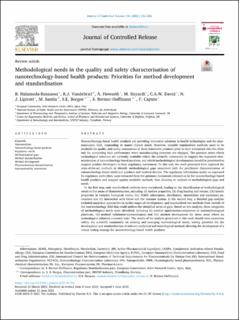| dc.contributor.author | Halamoda-Kenzaoui, Blanka | |
| dc.contributor.author | Vandebriel, Rob | |
| dc.contributor.author | Howarth, Alice | |
| dc.contributor.author | Siccardi, Marco | |
| dc.contributor.author | David, Chris | |
| dc.contributor.author | Liptrott, Neill | |
| dc.contributor.author | Santin, Marco | |
| dc.contributor.author | Borgos, Sven Even F. | |
| dc.contributor.author | Bremer-Hoffmann, Susanne | |
| dc.contributor.author | Caputo, Fanny | |
| dc.date.accessioned | 2022-09-08T13:28:08Z | |
| dc.date.available | 2022-09-08T13:28:08Z | |
| dc.date.created | 2021-11-30T11:00:47Z | |
| dc.date.issued | 2021 | |
| dc.identifier.citation | Journal of Controlled Release, 2021, 336, 192-206. | en_US |
| dc.identifier.issn | 0168-3659 | |
| dc.identifier.uri | https://hdl.handle.net/11250/3016666 | |
| dc.description.abstract | Nanotechnology-based health products are providing innovative solutions in health technologies and the pharmaceutical field, responding to unmet clinical needs. However, suitable standardised methods need to be available for quality and safety assessments of these innovative products prior to their translation into the clinic and for monitoring their performance when manufacturing processes are changed. The question arises which technological solutions are currently available within the scientific community to support the requested characterisation of nanotechnology-based products, and which methodological developments should be prioritized to support product developers in their regulatory assessment. To this end, the work presented here explored the state-of-the-art methods to identify methodological gaps associated with the preclinical characterisation of nanotechnology-based medicinal products and medical devices. The regulatory information needs, as expressed by regulatory authorities, were extracted from the guidance documents released so far for nanotechnology-based health products and mapped against available methods, thus allowing an analysis of methodological gaps and needs.
In the first step, only standardised methods were considered, leading to the identification of methodological needs in five areas of characterisation, including: (i) surface properties, (ii) drug loading and release, (iii) kinetic properties in complex biological media, (iv) ADME (absorption, distribution, metabolism and excretion) parameters and (v) interaction with blood and the immune system. In the second step, a detailed gap analysis included analytical approaches in earlier stages of development, and standardised test methods from outside of the nanotechnology field that could address the identified areas of gaps. Based on this analysis, three categories of methodological needs were identified, including (i) method optimisation/adaptation to nanotechnological platforms, (ii) method validation/standardisation and (iii) method development for those areas where no technological solutions currently exist. The results of the analysis presented in this work should raise awareness within the scientific community on existing and emerging methodological needs, setting priorities for the development and standardisation of relevant analytical and toxicological methods allowing the development of a robust testing strategy for nanotechnology-based health products. | en_US |
| dc.language.iso | eng | en_US |
| dc.publisher | Elsevier | en_US |
| dc.rights | Navngivelse 4.0 Internasjonal | * |
| dc.rights.uri | http://creativecommons.org/licenses/by/4.0/deed.no | * |
| dc.title | Methodological needs in the quality and safety characterisation of nanotechnology-based health products: Priorities for method development and standardisation | en_US |
| dc.type | Peer reviewed | en_US |
| dc.type | Journal article | en_US |
| dc.description.version | publishedVersion | en_US |
| dc.rights.holder | © 2021 The Authors. Published by Elsevier B.V. | en_US |
| dc.source.pagenumber | 192-206 | en_US |
| dc.source.volume | 336 | en_US |
| dc.source.journal | Journal of Controlled Release | en_US |
| dc.identifier.doi | 10.1016/j.jconrel.2021.06.016 | |
| dc.identifier.cristin | 1961514 | |
| cristin.ispublished | true | |
| cristin.fulltext | original | |
| cristin.qualitycode | 2 | |

